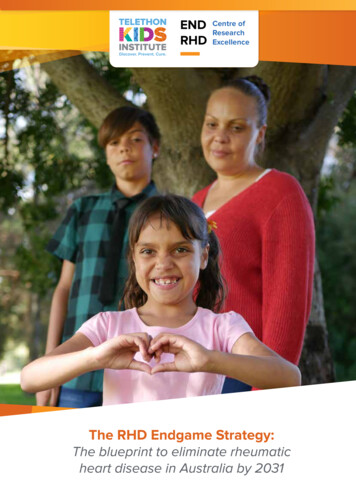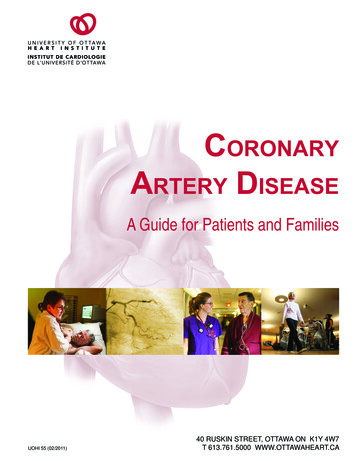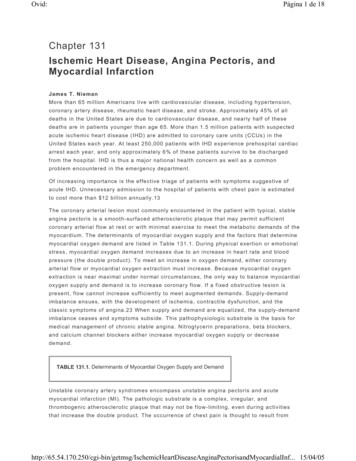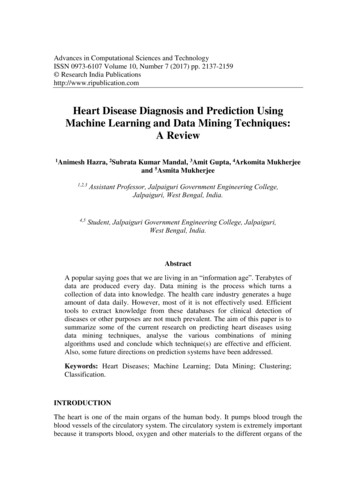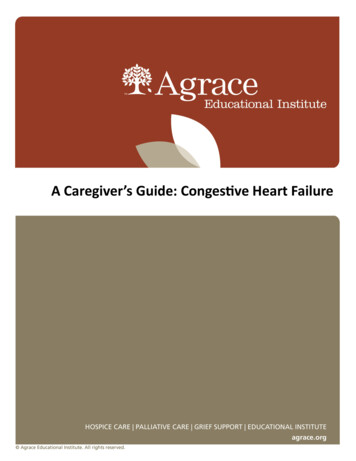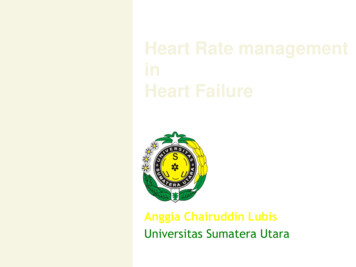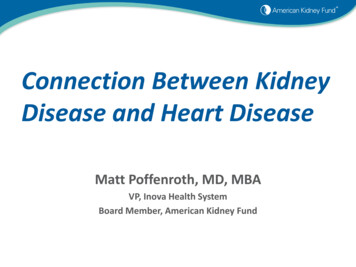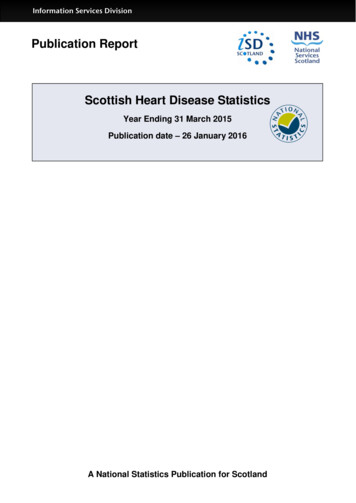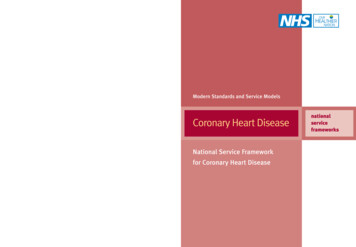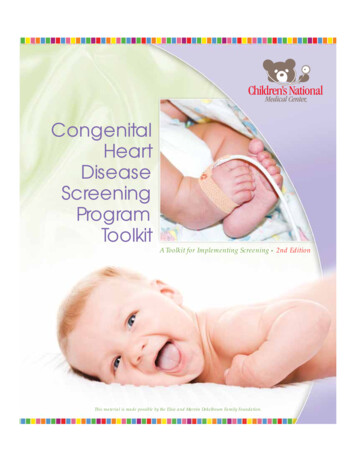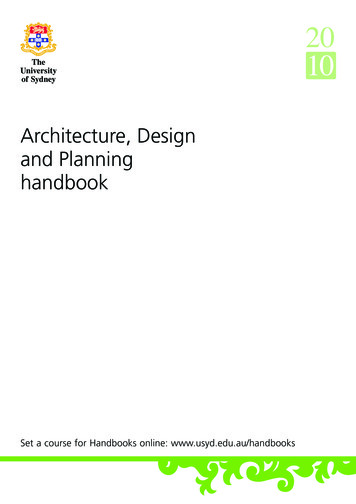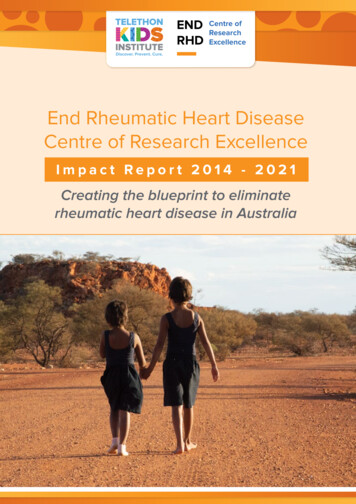
Transcription
ENDRHDCentre ofResearchExcellenceEnd Rheumatic Heart DiseaseCentre of Research ExcellenceImpact Report 2014 - 2021Creating the blueprint to eliminaterheumatic heart disease in Australia
AcknowledgementsContentsThe END RHD Centre of Research Excellence (END RHD CRE), was funded by a grant from the NationalHealth and Medical Research Council (NHMRC). Grant Identification Number for the Research Activity:1080401. Financial and in-kind support was also provided by the Telethon Kids Institute and The University ofWestern Australia. The work described in this report is a product of collaboration between researchers, andAboriginal and Torres Strait Islander leaders, communities, and people with lived experience.ACKNOWLEDGEMENTS 2The END RHD CRE investigators would like to thank the Aboriginal and Torres Strait Islander peoplewho have shared their stories over the life of the CRE. We acknowledge that the figures outlined inour research represent the loss of human life with profound impact and sadness for people, families,community, and culture.SPECTRUM OF WORK 6We thank all those who have contributed their technical expertise, time, and advice to the researchundertaken over the past six years of the CRE.The Telethon Kids Institute acknowledges Aboriginal and Torres Strait Islander peoples as the TraditionalCustodians of the land and waters of Australia, and the lands upon which this report was produced. We alsoacknowledge the Nyoongar Wadjuk, Yawuru, Kariyarra and Kaurna Elders, their peoples and their land uponwhich the Institute is located, and seek their wisdom in our work to improve the health and development ofall children.This document should be read in conjunction with Wyber R, et al. The RHD Endgame Strategy: Theblueprint to eliminate rheumatic heart disease in Australia by 2031. Perth: The END RHD Centre of ResearchExcellence, Telethon Kids Institute, 2020. 2021 Telethon Kids Institute. This work is protected by copyright. You may download, display, print,reproduce, and communicate this material in an unaltered form (retaining this notice) for your personal, noncommercial use or non-commercial use within your organisation. The authors reserve all other rights in thiswork, including all rights arising under the Copyright Act 1968 (Cth)CONTENTS 3A MESSAGE FROM PROFESSOR JONATHAN CARAPETIS4END RHD CRE VISION 6TIMELINE AND MILESTONES 7CHIEF INVESTIGATORS10ASSOCIATE INVESTIGATORS11THE RHD ENDGAME STRATEGY12CRE IN NUMBERS14IN FOCUS: THE MISSING PIECE STUDY15IN FOCUS: END RHD COMMUNITIES16RESEARCH SUPPORT20FUNDED PROJECTS22FINANCIAL OVERVIEW26What isRHD?Rheumatic heart disease (RHD)starts with a Strep A infection of the throator skin. When left untreated, the infectioncan lead to acute rheumatic fever (ARF),which causes sore joints, rash, fevers,and heart inflammation. While theother symptoms of ARF go away,the heart damage remains – andthis is known as rheumaticheart disease.End Rheumatic Heart Disease Centre of Research Excellence: Impact Report 2014 - 2021 3
A MESSAGE FROM PROFESSORJONATHAN CARAPETISEND RHD CRE CHIEF INVESTIGATOROur goal when establishing the End RheumaticHeart Disease Centre of Research Excellence(END RHD CRE) in 2014 was to create a blueprintto prevent the next generation of Aboriginal andTorres Strait Islander children from bearing theemotional and physical scars of rheumatic heartdisease (RHD), and to ensure those already livingwith the disease were afforded the best qualityof life.With the release in September 2020 of the RHDEndgame Strategy: The blueprint to eliminaterheumatic heart disease in Australia by 2031, wehave achieved this goal. If fully implemented, theRHD Endgame Strategy provides the opportunityto prevent another 8,000 Aboriginal and TorresStrait Islander people from developing rheumaticheart disease or its precursor, acute rheumaticfever (ARF), within the next decade. In doing this,we will prevent 650 deaths and another 1,370people will avoid open heart surgery as a resultof RHD.Behind each of these statistics is a person,a family and a community – and a chance tochange the course of their life immeasurably.While I am immensely proud of the RHDEndgame Strategy, and the solutions it offers toend RHD in this country, I am even prouder ofthe way we have gone about creating this criticalpiece of work. Pairing the research of leadinginfectious diseases specialists from the ENDRHD CRE with the knowledge and experienceof Aboriginal and Torres Strait Islander leadersacross the country, the RHD Endgame Strategymarks a true example of collaboration acrosscommunities, sectors and backgrounds.4While on paper the END RHD CRE constitutes 20investigators from 16 institutions across Australia,in reality the sum of the centre is far greater.At the heart of all of our work has been thoseliving with and at risk of RHD. These voices havebeen integral to creating the recommendationsthat will translate into acceptable, culturallyappropriate strategies that will be bothwelcomed by and successful within communitiesto end RHD once and for all.The RHD Endgame Strategy has been endorsedby 26 leading health and research organisations,including the National Aboriginal CommunityControlled Health Organisation (NACCHO).As the backbone of the organisations on thefrontline working to prevent new cases andsupport those living with the disease, theAboriginal and Torres Strait Islander healthworkforce is integral to actualising the visionof the RHD Endgame Strategy, and seeing thisdisease eliminated. I thank them enormously fortheir time, wisdom and passion, and stand readyto support them as they lead the next phase ofimplementation.From the beginning, we have also engagedgovernments and other key stakeholders toensure that the recommendations of the RHDEndgame Strategy are funded – and thatthis is not a report that sits on the shelves ofpowerbrokers gathering dust. As a foundingmember of the END RHD alliance, we haveengaged politicians and policymakers fromacross the political spectrum. For too long,RHD has been seen as a problem too largeand too multifaceted to be solved. With theRHD Endgame Strategy, we have proven notEND RHD CRE Chief Investigator Professor Jonathan Carapetis, examines Laqueisha, aged 5, as she recoversfrom open heart surgery to repair heart damage caused by rheumatic heart diseaseonly that it can it be ended, but that in fact, it isunconscionable not to do so.It has been my honour and privilege to lead theEND RHD CRE over the past six years and I thankevery single person who has contributed theirwisdom, technical expertise and lived experiencealong the way.Endgame Strategy, the evidence base to makeour vision to see this disease eliminated by 2031a reality. We simply cannot stop until this diseaseis ended – the next generation of Aboriginal andTorres Strait Islander children is depending on us.Professor Jonathan Carapetis AMAfter nearly 30 years working to eliminate RHDin Australia, I have never been more confidentthat the end is in sight. We have the Aboriginaland Torres Strait Islander leadership, communitydemand and, with the release of the RHDEnd Rheumatic Heart Disease Centre of Research Excellence: Impact Report 2014 - 2021 5
SPECTRUM OF WORKVisionFrom Science to Strategy: inputsand outputs of the END RHD CREThis diagram reflects the spectrum of work associated with the END RHD CRE.Partnerships and collaborations were strengthened across the life of the projectand research findings and impact were amplified by this collaborative approachThe END RHD Centre of Research Excellence wascreated with the vision of eliminating rheumaticheart disease as a public health priority in AustraliaEchoscreeningstudies /active casefindingEnvironmentalHealthHow we worked: Science to StrategyStrep Abiology,antibioticresistanceThe END RHD Centre of Research Excellence was designed as a research-policy-service partnershipto develop the first evidence-based strategy to end rheumatic heart disease in Australia, bringing theprevalence of rheumatic heart disease for Aboriginal and Torres Strait Islander peoples down to the samelevel as non-Indigenous people in Australians.When the END RHD CRE was funded in 2014, RHD control was at a critical juncture in Australia. Morethan 20 years of research closely linked to service delivery and policymaking had placed Australia at theforefront of global ARF and RHD research, control and advocacy, however a surge of co-ordinated researchand implementation strategies was needed to accelerate progress. The END RHD CRE provided anopportunity for a strategic approach targeting implementation science, encompassing all domains of diseasecontrol, consolidating existing strategies, developing new interventions with potential for rapid benefits, andmodelling the effect of potential interventions.The production of the Endgame Strategy involved the synthesis of information across the five-year lifespanof the END RHD CRE. Funding was allocated to priority research projects across several disciplines ofresearch, including epidemiology, economics, biomedical sciences, clinical practice, health servicesresearch and social sciences, with a dedicated focus on engaging the RHD community and documentingthe experiences of those living with the disease. Data and results from these priority projects helped informthe overall Endgame Strategy and were complemented by literature reviews, systematic reviews, narrativereviews and the experiences of health professionals currently working in ARF and RHD control.The complexity of RHD means that tackling it properly requires strategies across all levels of health care.This includes different health sectors as well as sectors dealing with social determinants – requiringextensive collaboration beyond the research community. The END RHD CRE brought together Aboriginaland Torres Strait Islander community-controlled organisations, policy and practice experts from the housing,environmental health and health provider sectors, and people living with RHD to inform the development ofthe Endgame Strategy.The END RHD CRE acknowledged that these stakeholders and experts – so critical in developing theEndgame Strategy – would also ultimately be responsible for the implementation of the recommendationsof the Endgame Strategy. This model of stakeholder and community engagement was central to the work ofthe CRE and its commitment to seeing its world-class research translated into action.6Missing Pieces(skin pharyngitisburden seDrugReactions(Uganda /Aust)PK – Perth,Darwin, NZSToP TrialKimberleyunderstanding ofassociations betweenhealth and environment,and of biological,environmental andsocial mechanismsinvolvedLivedexperienceof RHDPriorityprojectsand PhDprojectsSkin HealthInvestigatingand reducing theburden of skininfectionsENDRHDCREENDRHDStrep Abiologyand vaccinesCANVASMolecular microbiology,cell biology and immunologyapproaches to identifyimproved treatmentsand targets fornew vaccinesAustralianStrep AVaccineInitiative(ASAVI)ARF andRHD ClinicalGuidelinesPolitical and policyengagement &advocacyPreferences(NZ, Aust)IM/SCcomparisonSurgicaltiming igating waysto develop a betterformulation of penicillinthat will provide apractical, less painfulmethod of treatmentand protection.Burdenof disease,data linkageproject F causes& diagnosisUsing genomicstechnologies to profilethe immunologicaland metabolomicphenotype ofpeople withARFRHDActionARFimmunology(Uganda)ARF andRHD ClinicalGuidelinesSTART Study:ARF diagnosisEnd Rheumatic Heart Disease Centre of Research Excellence: Impact Report 2014 - 2021 7
MAY: Annual CRE InvestigatorsMeeting: Strep A SpectrumMeeting, PerthEND RHD: The release of theAustralian Medical AssociationIndigenous Report Card on RHDin 2016 was the catalyst for theformation of END RHD: an allianceof health, research and communityorganisations seeking to amplifyefforts to end rheumatic heartdisease in Australia throughadvocacy and engagement. This isthe first time such a broad-basedalliance has come together to tackleRHD. One of the key aims of ENDRHD was to secure the funding andthe political will to turn the worldclass research conducted by theEND RHD CRE into action.OCT: 950,000 investment bythe Commonwealth Departmentof Health to establish anEND RHD Community in theKimberleyDEC: Cost of Inaction on RHDreport releasedDEC: 500,000 investmentby Bupa Health Foundation tosupport END RHD Communitiesin the NTPriority ResearchAreas established andfirst funded projectscommencedEND RHD CRENHRMC grantannouncedNOV: Launch of AMAIndigenous Report Cardon RHD and creation ofthe END RHD advocacyalliance2014MAY: 1st edition of the AustralianHealthy Skin GuidelineFEB: FirstInvestigatorsmeeting in PerthMAY:: Launch ofEND RHD CRERHD Resolution: The resolution was passedat the 71st World Health Assembly in Geneva,attended by delegates from 194 WHO MemberStates. The commitment aims to consolidateefforts worldwide towards the prevention, controland elimination of RHD. CRE investigators playeda key role through collaborative networks inproviding technical advice in the development ofthe resolution and advocating for its adoption.Timeline and milestonesSEP: RHD EndgameStrategy launched byJonathan Carapetis, PatTurner CEO NACCHOand the Hon. Greg Hunt,Minister for Health2020202120192017ASAVI: the Australian Strep AVaccine Initiative aims to reducethe disease burden causedby Strep A infection througheffective vaccination. ASAVIwill play a leading role in theglobal effort to develop a StrepA vaccine and will work closelywith public health organisations,industry and academic partners,and the International Strep AConsortium (known as SAVAC).The CRE was critical in securingthe grant funding.Centre ofResearchExcellenceEndgame Strategy informsRHD policy and strategyin States and the NorthernTerritory2018MAY: Annual CREInvestigatorsMeeting, DarwinENDRHDCost of Inaction Report: This is the first timethe human and financial cost of rheumaticheart disease has been modelled. The CRE ledthis work, with data collected and analysedthrough the NHMRC Project Grant ‘Burden ofrheumatic heart disease (RHD) and impact ofprevention strategies: comprehensive evidenceto drive the RHD Endgame’.DEC: END RHD commissioned todevelop the RHD Roadmap201620158Collaborative ImpactMAY: World Health Assemblyresolution on global action toeliminate RHDStrep A Spectrum meeting: the CRE broughttogether over 100 investigators, collaboratorsand investigators from the RHD and Strep Aresearch community which provided data to andprogressed the development of the EndgameStrategy, and fostered new collaborations.Collaborative ImpactFEB: 35 million in federal fundingawarded to consortium (ASAVI) ledby Telethon Kids to accelerate thedevelopment of a Strep A vaccineMAR: RHD Roadmap considered byCouncil of Australian Governments(COAG)FEB: Guideline for the the prevention,diagnosis and management of ARFand RHD (3rd edition) released,informed by CRE researchThe RHD Roadmap: ENDRHD, through NACCHO,was commissioned bythe then Minister forIndigenous Health,the Hon. Ken Wyatt,to produce the RHDRoadmap. Telethon KidsInstitute and NACCHOled the writing of theRoadmap, drawingheavily on the evidenceof the Endgame Strategyin its development.FEB: End of theEND RHD CREEndEnd RheumaticRheumatic HeartHeart DiseaseDisease CentreCentre ofof ResearchResearch Excellence:Excellence: ImpactImpact ReportReport 20142014 -- 20212021 9
CHIEF INVESTIGATORSProfessor Jonathan Carapetis AMDirector, Telethon Kids Instituteand head of the Telethon KidsInstitute Strep A and RheumaticHeart Disease Team; Consultantpaediatrician, Perth Children’sHospital; Professor, The Universityof Western Australia; Co-directorof REACHProfessor Bart CurrieDirector, Infectious Diseases,Royal Darwin Hospital; Director,HOT NORTH; lead, Tropical andEmerging Infectious Diseasesteam, Global and TropicalHealth Division, MenziesSchool of Health ResearchAssoc/Prof Dan McAullayCentre Director, ISAC, TheUniversity of Western Australia;Principal Research Consultant,Kurongkurl Katitjin, EdithCowan UniversityProfessor Alex BrownTheme Leader, AboriginalHealth Equity, SAHMRI;Professor of AboriginalHealth, University of Adelaide;Scientific Director, AboriginalGrand Challenge, TelethonKids Institute; Co-director ofRHDAustraliaProfessor Andrew SteerPaediatric infectious diseasesphysician, Royal Children’sHospital Melbourne; PrincipalResearch Fellow, Centre forInternational Child Health,Department of Paediatrics,University of Melbourne;Group Leader, Strep AResearch Group at MurdochChildren’s Research Institute10ASSOCIATE INVESTIGATORSProfessor Graeme McGuireHead of Unit, GeneralInternal Medicine, WesternHealthProfessor Dawn BessarabDirector, Centre forAboriginal Medical andDental Health, TheUniversity of WesternAustraliaHeather D’AntoineDistinguished HonoraryFellow, Menzies Schoolof Health ResearchProfessor Anna RalphDirector, Global andTropical Health, MenziesSchool of Health Research;Co-director, RHDAustralia;Medical specialist, GeneralMedicine and InfectiousDiseases, Royal DarwinHospitalProfessor Nick de KlerkHonorary EmeritusFellow, Telethon KidsInstitute; AdjunctProfessor, OccupationalRespiratory Epidemiology,The University of WesternAustraliaProfessor David AtkinsonProfessor, Rural ClinicalSchool of WesternAustralia (Broome);Kimberley-basedmedical practitionerand researcherRebecca SladeProject Manager, PapuaNew Guinea & Republicof Indonesia for theMicro Elimination of TB,Menzies School of HealthResearch; ProgramManager, RheumaticHeart Disease Australia2018 - 2020Dr. Samantha ColquhounSenior Fellow, NationalCentre for Epidemiologyand Population Health,Australian NationalUniversityDr. Vicki KrauseDirector, Centre forDisease Control,Northern TerritoryProfessor Christopher ReidProfessorial ResearchFellow, cardiovascularepidemiology, School ofPopulation Health, CurtinUniversity; AssociateDirector, Monash Centre forCardiovascular Researchand EducationProfessor Tom SnellingDirector of Health andClinical Analytics, Schoolof Public Health, Universityof Sydney; Infectiousdiseases physician, SydneyChildren’s HospitalDr. Stephanie TrustPrincipal Physician,Wunan Health,KununurraDr. Rosemary WyberHead of Strategy forEND RHD, Telethon KidsInstitute; Senior AdjunctResearch Fellow, TheUniversity of WesternAustralia; PhD student,Health Systems Science,The George Institute forGlobal HealthDr. Gavin WheatonMedical Director ofPaediatric Medicine,Women’s and Children’sHospital, South AustraliaPrevious investigators:Karen Edmond (2015–17)and Claire Boardman (2015–18).End Rheumatic Heart Disease Centre of Research Excellence: Impact Report 2014 - 2021 11
THE RHD ENDGAME STRATEGYRHD Endgame Strategy inputsFive Priority Action Areas for l & TorresStrait IslanderleadershipCare ulEvidenceHealthyenvironmentsEarly preventionHon Greg Hunt MP, Jonathan Carapetis, END RHD Chief Investigator, and Pat Turner, NACCHO CEODataOn Wednesday 23 September 2020, the RHDEndgame Strategy: the blueprint to eliminaterheumatic heart disease in Australia by 2031 wasvirtually launched to more than 100 invited guestsacross the country by The Hon. Greg Hunt, MP,Minister for Health, alongside Professor JonathanCarapetis AM, senior author of the Strategy, andMs Pat Turner AM, CEO of the National AboriginalCommunity Controlled Health Organisation.The Endgame Strategy – the seminal output fromthe END RHD CRE – had been five years in themaking and brought the collective experience ofcommunities, clinicians, Aboriginal CommunityControlled Health Organisations, governmentand non-government organisations together withmore than 25 years of research to outline how toeliminate RHD in Australia.Upon its launch, Professor Carapetis notedthe Strategy’s release marked the first timea comprehensive evidence base had beendeveloped showing how this could be done.“With the release of this EndgameStrategy we now have the blueprintoutlining exactly what needs to happento both prevent new cases and improvethe quality of life for those alreadyliving with the disease,” ProfessorCarapetis said.RHD is rare among non-Indigenous people, yetAboriginal and Torres Strait Islander people havesome of the highest rates of the disease in theworld. This is a disease that is usually only seen12in developing countries and its persistence inAustralia is an ongoing injustice.“We know, without any shadow ofa doubt, that by implementing theEndgame Strategy, we can prevent thenext generation of Aboriginal and TorresStrait Islander children and their familiesfrom bearing the physical and emotionalscars of rheumatic heart disease.Structural/systems reformPrinciples/ways of workingInvestment in social& environmentaldeterminantsMeasurable targets/indicatorsCritical enabling factorsImplementation PrinciplesThe END RHD CRE supports the current reform agenda initiated by leading Aboriginal and Torres StraitIslander organisationsestablish new ActionClosing the Gaptargets, whichrepresents a newtoway of workingFrom research to action: this implementation framework comprisesFive toPriorityAreasdesignedto ensure meaningful improvements in outcomes for Aboriginal and Torres Strait Islander peoples. Thesereforms have set principlesand prioritiesa co-design approach.These willguide the ofimplementationoperationalise the Endgame Strategy. This framework was developedthroughanforanalysisof therangeof the Endgame Strategy and provide a basis for the Aboriginal and Torres Strait Islander-led consultationprocess,impactful,which will be the firststage of implementation.In short, how theandEndgameStrategy is implementedstrategies identified in the Endgame Strategy as being the mostacceptable,practicalreadilyis as, if not more, important as which specific strategies are implemented.implementable with appropriate investment.Adherence to the COAG Implementation Principles (agreed in 2018) and the reform priorities agreed by2the Joint Council on Closing the Gap (in 2019)2 is paramount. In addition, the END RHD CRE supports theprinciples agreed at the Indigenous Data Sovereignty Summit in 2018, which asserts the right of Aboriginaland Torres Strait Islander people to exercise control of the data ecosystem, have readily available andaccessible data, attain relevant data sustaining self-determination, and accountable data structuresrespecting individual and collective interests.3RHD Endgame Strategy outputs“We can also have an impact on other diseaseswith similar risk factors, such as otitis media,trachoma and renal disease.”Developed with the input and endorsement of theAboriginal and Torres Strait Islander CommunityControlled Health Sector via END RHD – the peakbody leading work to end rheumatic heart diseasein Australia – and more than 20 of Australia’sleading health and research organisations, theEndgame Strategy has the widespread supportof both those living with the disease and thoseworking to end it.The Endgame Strategy proposes a series ofinitiatives which take into account the individualcontext and needs of remote communities andensure Aboriginal and Torres Strait Islanderleadership is guaranteed.To set the foundations needed to make endingRHD achievable within the next decade, theStrategy outlines five key priorities for immediateattention which, collectively, have the greatestpotential to bring about ions1. R Wyber, K Noonan, C Halkon, S Enkel, J Cannon, E Haynes E, et al. Ending rheumatic heart disease in Australia: the evidence for anew approach. Medical Journal of Australia. 2020;213:S3-S31.2. R Wyber, K Noonan, C Halkon, S Enkel, A Ralph, AC Bowen, et al. The RHD Endgame Strategy: A Snapshot. The blueprint to eliminaterheumatic heart disease in Australia by 2031. Perth: The END RHD Centre of Research Excellence, Telethon Kids Institute; 2020.3. R Wyber, K Noonan, C Halkon, S Enkel, A Ralph, AC Bowen, et al. The RHD Endgame Strategy: The blueprint to eliminate rheumaticheart disease in Australia by 2031. Perth: The END RHD Centre of Research Excellence, Telethon Kids Institute; 2020.4. R Wyber, J Cannon, JM Katzenellenbogen. The cost of inaction on rheumatic heart disease: the predicted human and financial costsof rheumatic heart disease for Aboriginal and Torres Strait Islander people 2016-2031. Perth: The END RHD Centre of ResearchExcellence, Telethon Kids Institute; 2018.5. J Cannon, J Katzenellenbogen, R Wyber et al. The Cost of Inaction on Rheumatic Heart Disease in Australia. Heart, Lung andCirculation. 2019: 28(2): S50End Rheumatic Heart Disease Centre of Research Excellence: Impact Report 2014 - 2021 13
CRE IN NUMBERSIN FOCUS:THE MISSINGPIECE STUDYProject locationsNumber relatesto # of projectsDr Dylan Barth and the Missing Pieces team on school surveillance visitsin Broome and Derby5 4InvestigatorsNumber relatesto # of investigators‘The Missing Piece’: A surveillance study to understand the contribution ofStrep A pharyngitis in the context of high impetigo prevalence to inform primaryprevention of Acute Rheumatic Fever9Associate Professor Asha Bowen, Telethon Kids InstituteThere is a well-established causal pathogenic linkbetween infection of the throat with Strep A andsubsequent development of ARF. What is less clearis whether other types of Strep A infections, suchas impetigo (skin sores), may also contribute to thedevelopment of ARF.6 42222119researchprojectsinvestigatorslocated acrossacross6221investigators in thetop 30 world-rankingsfor RHD research5citiesandlocations inAustralia6ruraltowninvestigators in thetop 30 world-rankingsfor acute rheumaticfever research200 collaboratorsIt is reasonable to suggest that an impetigo-ARFlink does exist in Australian Aboriginal populationswhere rates of ARF and RHD are high, butwhere skin sores are endemic and pharyngitisis seemingly uncommon. This hypothesis is alsobacked by molecular analysis of Strep A bacteria inremote Aboriginal communities.Given that primary prevention strategies and effortsin vaccine development have long been based onthe belief that ARF is caused exclusively by StrepA pharyngitis, it is vital that we better understandthe concurrent burden of Strep A skin and throatinfections in individuals in endemic, tropical andresource-limited settings, so as to better targetprimary prevention strategies.Hence, the Missing Piece study – launched in2019 and still ongoing – aims to comprehensivelyevaluate the concurrent burden (prevalenceScholarshipsand support for6PhDstudentsand incidence) of Strep A impetigo and Strep Apharyngitis in Aboriginal children aged 5–15 yearsin the Western Australian Kimberley region. Thetwo schools participating in this study are based inBroome and Derby, Western Australia.To date, the Missing Piece Study has completedthree screening visits, including 438 participantsand collection of 405 throat and 118 skin swabs.Swabs of the classroom environment have alsobeen undertaken to determine if Strep A persistson classroom surfaces.In 2020 an Honours student worked on this studyto analyse the baseline data for sore throats andskin sores. This was the first description of StrepA sore throats in remote-living Aboriginal childrenat high risk of acute rheumatic fever (ARF) in morethan a decade, confirming higher than expectedrates of Strep A pharyngitis.As a result of activities having been disrupted byCOVID-19 across the Kimberley, the Missing Piecestudy has secured a successful WA Child HealthResearch Fund grant to continue surveillanceactivities in 2021 and progress research onenhancing primary prevention strategies for ARF.Peer-reviewed publications1. S Pearce, AC Bowen, ME Engel, M de la Lande, DD Barth. The incidence of sore throat and group A streptococcal pharyngitisin children at high risk of developing acute rheumatic fever: A systematic review and meta-analysis. PLoS One, 2020. 15(11):e0242107.2. J Pickering, DD Barth, AC Bowen. Performance and practicality of a rapid molecular test for the diagnosis of Strep A pharyngitis ina remote Australian setting. American Journal of Tropical Medicine & Hygiene, 2020. 103(6): 2530-2532.5very high impact publicationsand more than200networked collaborator publications3. DD Barth, J Daw, R Xu, S Enkel, J Pickering, T McRae, ME Engel, JR Carapetis, R Wyber and AC Bowen. Modes of transmissionand attack rates of group A Streptococcal infection: a protocol for a systematic review and meta-analysis. BMC SystematicReviews, 2021. 10: 90.4. DD Barth DD, M Mullane, C Chou, JR Carapetis, AC Bowen A. The design and rationale of the Missing Piece Surveillance Studyfor Strep A pharyngitis and impetigo infections in Australia. BMJ Open. Manuscript under preparation.14End Rheumatic Heart Disease Centre of Research Excellence: Impact Report 2014 - 2021 15
IN FOCUS:END RHD COMMUNITIES“Take for example, complexities around locallanguage,” Ms Kelly said. “Germ theory ascausation of disease is a difficult concept totranslate, so Aboriginal Community Workers playthe critical role of being able to explain the bestway to prevent contracting a Strep A infection inthe local context.”Given that preventing Strep A infection requirespeople to have access to appropriate healthand hygiene infrastructure – in turn helping toclose the gap – researchers hope its benefits willstretch beyond simply tackling RHD.Valerina Mungatopi, Anne-Marie Lee, Nina Black, Angela Kelly, Segora Babui at an END RHD Communitiestraining day held in DarwinBuilding on the learnings of the CRE-funded SPPlus Project, in 2018 the ‘END RHD Communities’project commenced in two remote AboriginalCommunities in the Northern Territory, supportedby the Bupa Health Foundation and driven by theEND RHD CRE in c
The END RHD Centre of Research Excellence was designed as a research-policy-service partnership to develop the first evidence-based strategy to end rheumatic heart disease in Australia, bringing the prevalence of rheumatic heart disease for Aboriginal and Torres Strait Islander peoples down to the same level as non-Indigenous people in Australians.
